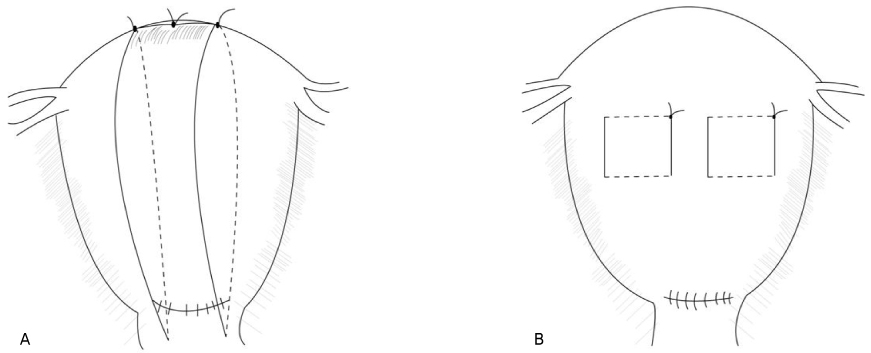Korean J Obstet Gynecol.
2010 Sep;53(9):769-777. 10.5468/kjog.2010.53.9.769.
Treatment outcome of uterine compression sutures for massive postpartum hemorrhage
- Affiliations
-
- 1Department of Obstetrics and Gynecology, Cheil General Hospital & Women's Healthcare Center, Kwandong University College of Medicine, Seoul, Korea. obdrmhk@naver.com
- KMID: 2077994
- DOI: http://doi.org/10.5468/kjog.2010.53.9.769
Abstract
OBJECTIVE
Uterine compression sutures such as modified B-Lynch suture or multiple square-shaped sutures of uterine body are simple methods for control of postpartum hemorrhage refractory to medical treatment. We evaluated the treatment outcome and morbidity of uterine compression sutures and analyzed clinical findings of patients undergone uterine compression sutures and postpartum hysterectomy.
METHODS
From January 2005 through December 2008, we retrospectively reviewed the medical records of patients undergone uterine compression sutures or postpartum hysterectomy. We analyzed success rates of preserving uterus of uterine compression sutures according to operative indications and mode of delivery and compared maternal characteristics, operative findings, morbidities and mortality with those of postpartum hysterectomy.
RESULTS
The frequency of uterine compression sutures for control of massive postpartum hemorrhage was 0.24% (73/30,677). The success rates of preserving uterus were 85.1% in uterine atony, 80.9% in placenta previa, and 40.0% in placenta accreta (P=0.051). The rates of preserving uterus of uterine compression sutures after vaginal delivery and cesarean section were 50.0% and 82.6%, respectively (P=0.164). The frequencies of postoperative morbidities such as disseminated intravascular coagulation, pulmonary edema, ileus were not different between immediate hysterectomy and hysterectomy after uterine compression sutures. There was no maternal mortality.
CONCLUSION
Uterine compression suture was successful method for control of postpartum hemorrhage resulting from uterine atony and placenta previa. We suggest the use of uterine compression sutures as the first-line operation for control of postpartum hemorrhage.
MeSH Terms
Figure
Reference
-
1. Maternal mortality in 2000: estimates developed by WHO, UNICEF, and UNFPA. Department of Reproductive Health and Research, World Health Organization. 2004. Geneva: World Health Organization;Available from: URL: http://whqlibdoc.who.int/publications/2004/92415-62706.pdf.2. Waterstone M, Bewley S, Wolfe C. Incidence and predictors of severe obstetric morbidity: case-control study. BMJ. 2001. 322:1089–1093.3. Baskett TF, O'Connell CM. Severe obstetric maternal morbidity: a 15-year population-based study. J Obstet Gynaecol. 2005. 25:7–9.4. B-Lynch C, Coker A, Lawal AH, Abu J, Cowen MJ. The B-Lynch surgical technique for the control of massive postpartum haemorrhage: an alternative to hysterectomy? Five cases reported. Br J Obstet Gynaecol. 1997. 104:372–375.5. Hayman RG, Arulkumaran S, Steer PJ. Uterine compression sutures: surgical management of postpartum hemorrhage. Obstet Gynecol. 2002. 99:502–506.6. Cho JH, Jun HS, Lee CN. Hemostatic suturing technique for uterine bleeding during cesarean delivery. Obstet Gynecol. 2000. 96:129–131.7. Meydanli MM, Turkcuoglu I, Engin-Ustun Y, Ustun Y, Kafkasli A. Meydanli compression suture: new surgical procedure for postpartum hemorrhage due to uterine atony associated with abnormal placental adherence. J Obstet Gynaecol Res. 2008. 34:964–970.8. Baskett TF. Uterine compression sutures for postpartum hemorrhage: efficacy, morbidity, and subsequent pregnancy. Obstet Gynecol. 2007. 110:68–71.9. Ouahba J, Piketty M, Huel C, Azarian M, Feraud O, Luton D, et al. Uterine compression sutures for postpartum bleeding with uterine atony. BJOG. 2007. 114:619–622.10. The Centre for Maternal and Child Enquiries. Why Mothers Die: Report on Confidential Enquiries into Maternal Deaths in the United Kingdom 2002-2004. Triennial Report. 2004. London: RCOG Press;94–103.11. El-Hamamy E, B-Lynch C. A worldwide review of the uses of the uterine compression suture techniques as alternative to hysterectomy in the management of severe post-partum haemorrhage. J Obstet Gynaecol. 2005. 25:143–149.12. Bhal K, Bhal N, Mulik V, Shankar L. The uterine compression suture: a valuable approach to control major haemorrhage at lower segment caesarean section. J Obstet Gynaecol. 2005. 25:10–14.13. Marasinghe JP, Condous G. Uterine compression sutures for post-partum bleeding with atony; modification of the B-Lynch suture. Aust N Z J Obstet Gynaecol. 2009. 49:67–70.14. Hwu YM, Chen CP, Chen HS, Su TH. Parallel vertical compression sutures: a technique to control bleeding from placenta praevia or accreta during caesarean section. BJOG. 2005. 112:1420–1423.15. Harma M, Gungen N, Ozturk A. B-Lynch uterine compression suture for postpartum haemorrhage due to placenta praevia accreta. Aust N Z J Obstet Gynaecol. 2005. 45:93–95.16. Shellhaas CS, Gilbert S, Landon MB, Varner MW, Leveno KJ, Hauth JC, et al. The frequency and complication rates of hysterectomy accompanying cesarean delivery. Obstet Gynecol. 2009. 114:224–229.17. Zeteroglu S, Ustun Y, Engin-Ustun Y, Sahin G, Kamaci M. Peripartum hysterectomy in a teaching hospital in the eastern region of Turkey. Eur J Obstet Gynecol Reprod Biol. 2005. 120:57–62.18. Clark SL, Yeh SY, Phelan JP, Bruce S, Paul RH. Emergency hysterectomy for obstetric hemorrhage. Obstet Gynecol. 1984. 64:376–380.19. Whang JD, Oh SY, Yoo JK, Yang SH, Lee JH, Roh CR. Clinical study on cesarean hysterectomy. Korean J Perinatol. 2000. 11:315–319.20. Barclay DL, Hawks BL, Frueh DM, Power JD, Struble RH. Elective cesarean hysterectomy: a 5 year comparison with cesarean section. Am J Obstet Gynecol. 1976. 124:900–911.21. Baker ER, D'Alton ME. Cesarean section birth and cesarean hysterectomy. Clin Obstet Gynecol. 1994. 37:806–815.22. Ochoa M, Allaire AD, Stitely ML. Pyometria after hemostatic square suture technique. Obstet Gynecol. 2002. 99:506–509.23. Grotegut CA, Larsen FW, Jones MR, Livingston E. Erosion of a B-Lynch suture through the uterine wall: a case report. J Reprod Med. 2004. 49:849–852.24. Joshi VM, Shrivastava M. Partial ischemic necrosis of the uterus following a uterine brace compression suture. BJOG. 2004. 111:279–280.


